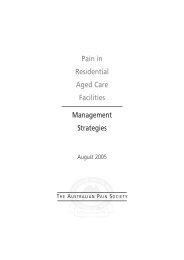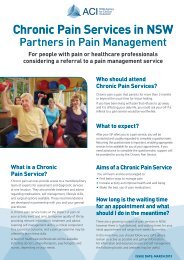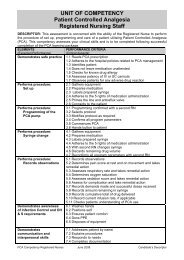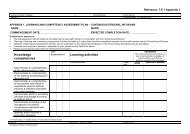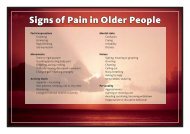The treatment of persistent pain - Australian Pain Society
The treatment of persistent pain - Australian Pain Society
The treatment of persistent pain - Australian Pain Society
Create successful ePaper yourself
Turn your PDF publications into a flip-book with our unique Google optimized e-Paper software.
Suzanne Scott<br />
Multidisciplinary <strong>Pain</strong> Centre, Royal Brisbane Hospital<br />
Robin Murray<br />
<strong>Pain</strong> Management and Research Centre, Royal North Shore Hospital<br />
Health pr<strong>of</strong>essionals who work with<br />
individuals who have <strong>persistent</strong> <strong>pain</strong> have<br />
difficulty at times in accounting for differences<br />
in outcome when those with similar complaints<br />
respond in ways that are unpredictable.<br />
(Pearce, Cramond, Creed, (2001). Bowlby’s attachment theory fits<br />
within the biopsychosocial model <strong>of</strong> <strong>persistent</strong> <strong>pain</strong> and may explain<br />
the sometimes puzzling behaviour <strong>of</strong> these individuals. This article relates<br />
differences in <strong>treatment</strong> outcome to differences in early developmental<br />
histories and examines the influence <strong>of</strong> secure and insecure attachment<br />
styles on the response <strong>of</strong> <strong>persistent</strong> <strong>pain</strong> sufferers to <strong>treatment</strong>.<br />
Attachment theory is a robust concept that is useful for health<br />
pr<strong>of</strong>essionals when assessing and treating <strong>persistent</strong> <strong>pain</strong>. It may<br />
explain the origins <strong>of</strong> help-seeking and self-caring behaviours <strong>of</strong> these<br />
individuals and help us to understand why certain behaviours are<br />
directed toward pr<strong>of</strong>essionals who are caring for them. At a time <strong>of</strong><br />
need individuals approach a carer in a particular manner and display<br />
certain behaviours that they learned within their family <strong>of</strong> origin.<br />
Children internalise experiences with caretakers and these attachment<br />
experiences become the prototype for their relationships in adult life.<br />
A child who grows up in a caring and nurturing family environment<br />
has the best chance <strong>of</strong> growing to maturity as a self confident adult<br />
with strong self respect, respect for others, and high self efficacy.<br />
In contrast, a child who has to survive in a dysfunctional family<br />
environment, has less chance <strong>of</strong> developing such strong personal<br />
resources. <strong>The</strong> quality and the type <strong>of</strong> the developmental influences<br />
on children determine their manner <strong>of</strong> attachment.<br />
Attachment behaviours become prominent when individuals are<br />
afraid or ill. <strong>The</strong>y approach or avoid their carers according to their<br />
internalised model <strong>of</strong> "self" and "other" at these times.<br />
2<br />
<strong>The</strong> <strong>treatment</strong> <strong>of</strong> <strong>persistent</strong> <strong>pain</strong><br />
<strong>The</strong> key constructs <strong>of</strong> this model are:<br />
1Whether or not the attachment figure is judged to be the<br />
sort <strong>of</strong> person who in general responds to calls for support<br />
and protection, &<br />
2Whether or not the self is judged to be the sort <strong>of</strong> person<br />
anyone, and in particular the person from whom care is<br />
sought, is likely to respond to in a helpful way.<br />
A "carer" is defined here as one with whom the person has a close<br />
emotional bond, or a health pr<strong>of</strong>essional. When individuals have<br />
<strong>persistent</strong> <strong>pain</strong> these carers become the source and the focus <strong>of</strong> help<br />
and support. <strong>The</strong> relationship an individual sets up with any <strong>of</strong> these<br />
carers reflects their model <strong>of</strong> interpersonal relationships. In times <strong>of</strong><br />
need, they are likely to approach a carer with the same behaviours<br />
and intensity that they brought to the relationship with an original<br />
carer such as the mother. It is suggested that this model <strong>of</strong> self and<br />
other is stable throughout life. (Ainsworth, 1982; Bowlby, 1944;<br />
George, Kaplan & Main, 1987).<br />
Attachment theory is relevant to health research and to clinicians because<br />
it has been shown that the particular behaviours that are the outcome<br />
<strong>of</strong> attachment learning determine in part, the ability <strong>of</strong> the individual<br />
to effectively manage and recover from illnesses, traumas or disabilities.<br />
Each <strong>of</strong> the models <strong>of</strong> attachment behaviour favours certain problem<br />
solving strategies. Clinicians generally consider the resources <strong>of</strong> the<br />
patient when considering ways in which information is presented or<br />
in attempting to remedy a problem. Cognitive abilities are usually<br />
taken into account, but it is less likely that the influence <strong>of</strong> emotional<br />
factors related to the individual’s attachment style will be considered.<br />
Our experiences as children influence our subsequent years at least<br />
until we are mature enough to make judgements less coloured by<br />
emotion. Bowlby made his first reports about the detrimental influences<br />
<strong>of</strong> dysfunctional families on children living within these families in<br />
1958. He reported that attachment behaviour is organised, learned<br />
and reinforced or extinguished by social interactions within the family<br />
(Bowlby, 1958). His theories are supported by Ferster and Perrott (1968).<br />
Ainsworth, Blehar, Waters and Wall (1978) classified the attachment<br />
styles <strong>of</strong> children according to their ability to recover from separation<br />
anxiety. Because children are vulnerable when sick or afraid, these<br />
researchers suggested that a strong supportive family environment<br />
not only gives the best possible chance for a child to recover from



